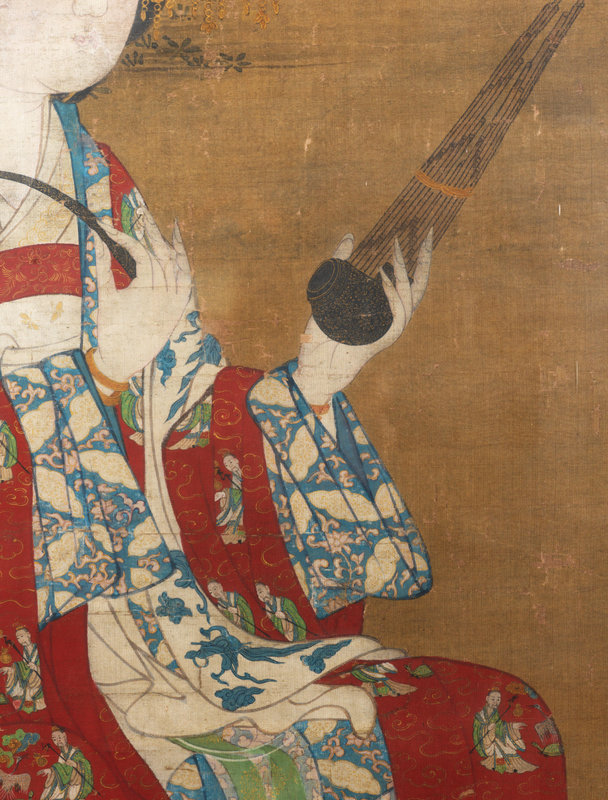Lot 62. A painting of a court lady and lady-attendant, Probably Ming Dynasty (1368-1644) or earlier, Ink and pigment on silk, with apocryphal seal of Song emperor Huizong, reading Neifu tushu zhi yin on the top left, seal of Jin dynasty emperor Zhangzong, reading Mingchang Yulan, collector's seal lower right reading Nanchang wanshi zhencang, framed and glazed. 135cm (53in) long x 56cm (22in) wide. Sold for €504,375 (Estimate 20,000 € - 30,000 €). Photo Fabrice Gousset.
Provenance: Robert Rousset, Paris (1901-1981), acquired prior to 1935
Jean-Pierre Rousset, Paris (1936-2021).
Note: The present lot depicts an elegant Court lady holding in her hand a sheng or free-reed wind instrument, seated outside beside a gnarled rock issuing peony. Behind her stands an attendant draped in green robes, the relatively large size of the lady indicates her importance compared to the smaller attendant.
The Court lady wears an elaborate headdress with seven phoenix, perhaps indicating that this is Bixia Yuanjun, the primordial sovereign of the dawn clouds, or Lady of Mount Tai. In Daoism, she is considered not only the Goddess of Mount Tai, but also of childbirth and destiny. She became an important deity particularly in the north of China during the Ming and Qing dynasties.
The detail of the clothes is particularly magnificent. The Lady is clad in gorgeously decorated robes detailed with a Daoist Immortal carrying a staff from which hangs a double-gourd containing an elixir, and facing a crane and tortoise, symbols of longevity. This again would seem to indicate that the figure is a deity or connected to Daoism.
In the centre of the painting is a spurious seal reading 'Mingchang Yulan', seal of the Jin emperor Zhangzong (r.1188–1208). Emperor Zhangzong attempted to supersede the former Song emperor Huizong as an art connoisseur and inherited a large collection of art which he inscribed or attached his seal to. See the painting, for example, of 'Lady Guoguo's Spring Outing', attributed to Zhang Xuan, where emperor Zhangzong added the three characters 'Tian shuimo', which actually belonged to Huizong; see Three Thousand Years of Chinese Painting, Yale, 1997, p.77. Another collector's seal on the bottom right reads 'Nanchang wanshi zhencang' which likely belonged to Wan Chengzi 萬承紫(1775-1837). In the upper left is another apocryphal seal reading 'Neifu tushu zhi yin' (內府圖書之印 'Seal for Painting and Calligraphy of the Palace Storehouses'), the seal of Emperor Huizong.
Although the painting echoes the work of Tang dynasty painter, Zhou Fang, and his 'Court Ladies Wearing Flowered Headdresses', illustrated in Wei Jin zhi Wudai huihua, Shijiazhuang, 2003, pp.86-87, with their large chignons and elaborate headdresses, the style of the painting would suggest a a later date. See for example, related figures of ladies in a Daoist wall painting 'Homage to the Highest Power', originally from the Longmen Monastery in Shanxi Province, c.1300, in the Royal Ontario Museum (acc.no.933.6.3).
Cette œuvre dépeint une élégante dame de Cour tenant un sheng (instrument à vent à anches libres), assise à côté d'un rocher tortueux traversé par un arbuste couvert de pivoines. Derrière elle se tient une suivante dans une robe verte, et la plus grande taille de la dame manifeste son importance.
La dame de Cour porte une coiffe élaborée à sept phénix, indiquant peut-être qu'il s'agit de Bixia Yuanjun, la souveraine primordiale des nuages de l'aube, appelée aussi Dame du Mont Tai. Dans le taoïsme, elle est non seulement la déesse du Mont Tai, mais aussi celle de l'accouchement et du destin. Elle devint une divinité importante, surtout dans le Nord de la Chine, durant les dynasties Ming et Qing.
Le détail des vêtements, en particulier, est magnifique. La dame est habillée de robes superbement décorées, dont une rouge présentant un motif d'immortel taoïste tenant un bâton où est accroché une double-gourde contenant un élixir, et faisant face à une grue et une tortue, des symboles de longévité. Ceci semble encore montrer que ce personnage est une divinité ou est lié au taoïsme.
Au centre de la peinture se trouve le sceau apocryphe « Mingchang Yulan », prétendument le sceau de l'empereur Zhangzhong (r. 1188-1208) des Jin. L'empereur Zhangzhong tenta de remplacer l'empereur Huizong des Song comme connaisseur des arts et hérita d'une vaste collection d'art sur laquelle il calligraphia ou apposa son sceau. Voir par exemple la peinture de L'excursion printanière de Dame Guoguo, attribué à Zhang Xuan, sur laquelle l'empereur Zhangzhong a ajouté les trois caractères « Tian shuimo », qui appartenaient en fait à Huizong, cf. Three Thousand Years of Chinese Painting, Yale, 1997, p.77. Il y a autre sceau de collectionneur en bas à droite, « Nanchang wanshi zhencang », probablement celui de Wang Chengzi 萬承紫(1775-1837). En haut à gauche se trouve un autre sceau apocryphe indiquant « Neifu tushu zhi yin » (內府圖書之印), le sceau de l'empereur Huizong.
Bien que la peinture évoque le travail du peintre Zhou Fang de la dynastie Tang et ses Dames de la Cour portant des coiffes fleuries illustrées dans Wei Jin zhi Wudai huihua, Shijiazhuang, 2003, pp.86-87, avec leurs grands chignons et coiffes élaborées, le style de cette peinture suggèrerait une date plus tardive. Voir par exemple des personnages comparables de dames sur une peinture murale taoïste, Homage to the Highest Power, provenant probablement du monastère de Longmen dans la province du Shaanxi, vers 1300, et conservé au Royal Ontario Museum (acc.no. 933.6.3).
Bonhams Cornette de Saint Cyr Paris. The Robert and Jean-Pierre Rousset Collection of Asian Art: A Century of Collecting - Part 1. Paris, 25 october 2022.

/https%3A%2F%2Fprofilepics.canalblog.com%2Fprofilepics%2F1%2F0%2F100183.jpg)
/https%3A%2F%2Fstorage.canalblog.com%2F03%2F02%2F119589%2F96711876_o.jpg)
/https%3A%2F%2Fstorage.canalblog.com%2F11%2F31%2F119589%2F94773502_o.jpg)
/https%3A%2F%2Fstorage.canalblog.com%2F20%2F83%2F119589%2F94772815_o.jpg)
/https%3A%2F%2Fstorage.canalblog.com%2F26%2F72%2F119589%2F75604929_o.jpg)
/https%3A%2F%2Fstorage.canalblog.com%2F59%2F60%2F119589%2F26458628_o.jpg)







/image%2F1371349%2F20240425%2Fob_78c699_440320998-1657454638357882-17494889713.jpg)
/image%2F1371349%2F20240421%2Fob_1dddd2_438878301-1654314112005268-81048289869.jpg)
/image%2F1371349%2F20240421%2Fob_df8c96_438328730-1653747745395238-34643333091.jpg)
/image%2F1371349%2F20240417%2Fob_961e87_437772831-1653147868788559-54808306367.jpg)